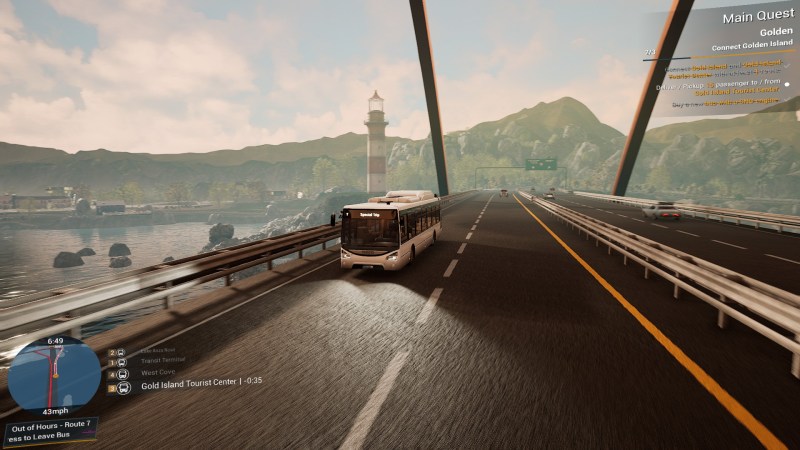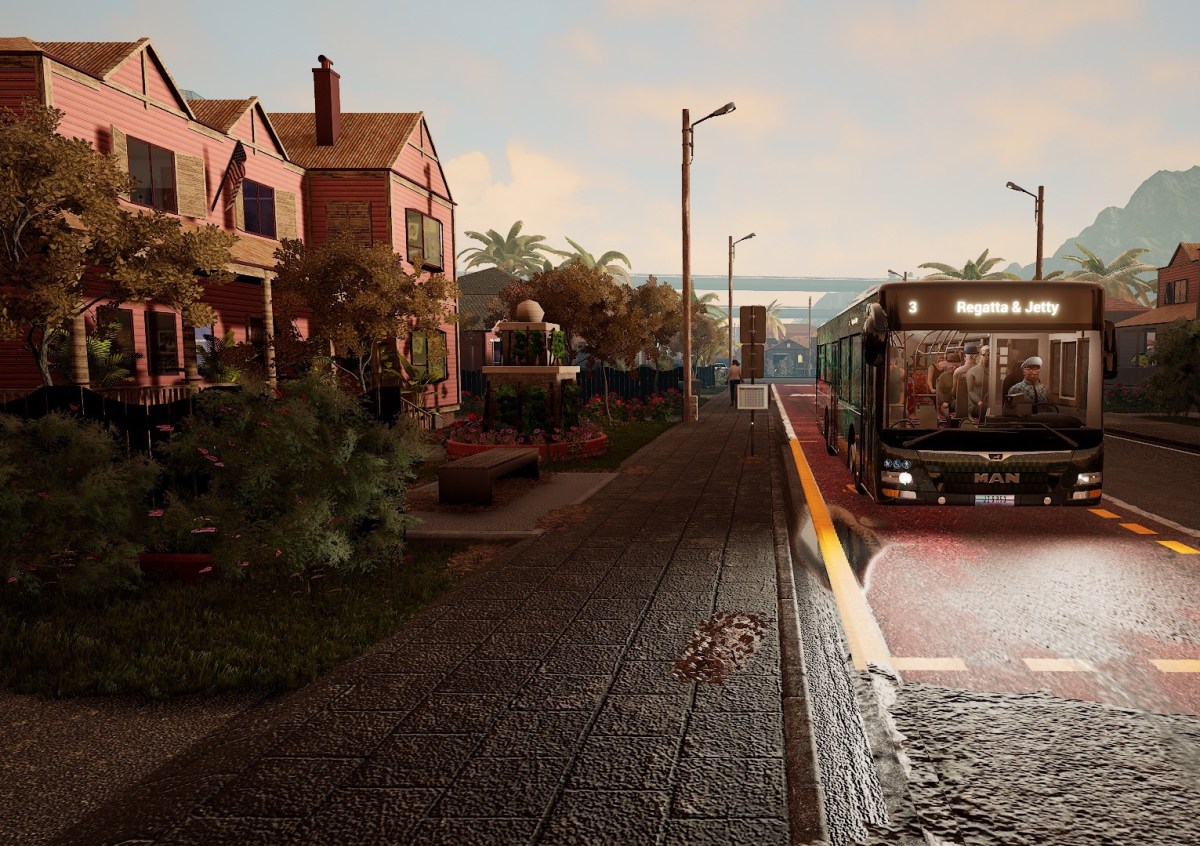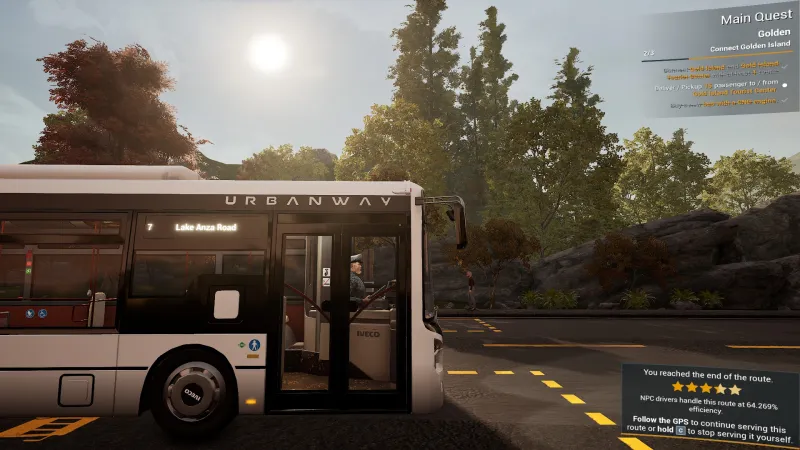Coming three years after Bus Simulator 18, Stillalive Studios has returned with the next entry in its hit franchise. Bus Simulator 21 kicks things into a higher gear with more freedom, streamlined mechanics, and a richer open-world map to explore.
In a lot of ways, it does feel like a much more put-together experience, but then there are other ways where it seems like the long development cycle wasn’t put to great use. That is to say, these “new” buses could use a little more engine oil.
 Shifting forward
Shifting forward
Where the newness of Bus Simulator 2 undoubtedly shines is certainly its new map of Angel Shores. It’s an absolutely gorgeous piece of virtual landscaping, with scenery and buildings that are very detailed. The texture work is crisp, and each of its 21 districts has a very unique look and theme, thus allowing them to stand out from one another. Not to mention the entire sim itself is just pretty. There are a lot of environmental and special effects such as reflections, wind animation, rain, and heavy reflections which do solidify that this is a 2021 release.
Another tech flex is that the entire map is now one seamless open-world. Once you load, you’ll rarely have to load again, aside from when fast traveling is needed. Having played the sim with an SSD, I can report that from startup to jumping in-game, it’s always only ever taken a few seconds. This certainly comes in handy when making full use of the revamped bus route system.
Map minutes
Unlike its predecessor, Bus Simulator 21 allows players to create new bus routes on the fly while still within a session. Simply navigate to the Map menu and start plotting away. Bus routes can be linked together efficiently by means of checking different characteristics of each of the stops.
Each bus stop has a different level of demand and different peak hours. Routes will be considered “balanced” if the most compatible stops are chained together. For example, having a route that consists of three low-demand stops and three high-demand stops will be balanced. But, three low-demand stops with just one high-demand stop will be unbalanced. Alternatively, a route of six stops with five of them peaking at night would be more profitable than two of them being in high demand at night and three being high-demand in the day. Some quests will specifically require routes to be nighttime or daytime oriented, whereas others specifically ask for certain stops to be included.
An added layer of depth to the route building system is an RPG-esque experience system. Not only do you gain EXP as a player, but each bus stop also gains EXP anytime it is served during a route—but only by the player. AI drivers can only generate profit from routes. Once every bus stop in a district is leveled up, then the district’s own EXP level will also increase. Again, some missions require leveling up in order to progress the campaign mode.
Unfortunately, Bus Simulator 21 doesn’t do an overly great job at explaining little nuances like this. In fact, I’d say its UI has both too much and too little information at once. Some parts of it, particularly the map screen, are arguably a little overwhelming. But, then there are the moments where you have an objective, but the sim doesn’t explain exactly what’s needed to achieve it. Hopefully, the developers can make some adjustments so as not to frustrate newer or more casual players.
Speaking of frustration, however, my gripes mainly lie with the most important part of the sim: the driving mechanics. Real-life buses are not the easiest machines to control by any means, but these virtual creations feel almost a little too cumbersome to maneuver. While some buses, particularly smaller ones, roll and turn a little more easily than others, the overall physics system just felt odd to me.
Potholes present
Despite me fiddling with the steering sensitivity and assistance percentages throughout my time with the sim using an Xbox One controller, I have yet to find something that feels “just right”. I wasn’t even expecting to have this issue as I recently purchased a Thrustmaster T80 wheel for such occasions. While it’s been a darling to use with American Truck Simulator, Bus Simulator 21 simply seems to only halfway acknowledge it at the time of release. While the sim recognizes the steering, pedal, and brake axis, it fails to register any of the buttons, thus leaving too many gameplay mechanics unaccounted for. Switching between the wheel, controller, and keyboard to fulfill every task would’ve been too tall of an order.
The one really good point is that controller support is at least well-integrated thanks to the action wheel. This wheel allows you to control many extra features in the bus’ cockpit, which far outweighs the number of buttons on any controller. Still, the core gameplay of Bus Simulator 21 remains pretty fun. Especially now that you can seamlessly swap between routes all without leaving the session makes everything flow. If you ever get bored of one route, simply pass it off to an AI driver, and then jump to another route mere moments later.
A new route can even be created while still riding along in the initial bus, and then you can either assign an available bus to the new route or reassign an active bus at will with no penalties. All of this freedom makes things feel quick, but the progression is still a slow-and-steady affair, whether it be grinding for EXP or cash. At least when it’s a money matter you can always sell one of your buses to make a quick $100,000+.
Clean the windshield
Bus Simulator 21 clearly has some strong points, but in addition to the aforementioned issues, there are other areas that I hope to see rectified to really help its engine purr. The AI pedestrians are everywhere, but there’s not a lot of model variety. Voice acting is also plentiful, but there’s a similar lack of variety in the number of different actors. I ended up disabling dialogue altogether just to have peace. They do at least realistically react to approaching vehicles by speeding up, which shows a step-up in intelligence. But, my fleet of AI drivers doesn’t seem to be as intelligent as taking some turns seems to be an issue, as well as pulling away from a stop as they tend to linger for a noticeable bit of time.
But what really interrupts this otherwise sweet ride is the sim’s performance. While I did sing its praises for its graphical fidelity, Bus Simulator 21 seems to be a little heavy-handed on the resource requirements. When not driving, the sim would hit a solid 60fps (v-synced) on my rig with an RTX 2060 and Core i7. Yet, taking control of a bus always resulted in the framerate immediately tanking to the 40fps range, and sometimes lower. Playing with settings did help a bit, but it’s not as smooth as I was expecting. Perhaps some further optimization is needed, as a colleague of mine noticed similarly choppy performance on an even more capable machine.
Despite these caveats, Bus Simulator 21 is still a step in the right direction for the series. For better or worse, veterans of the last entry will find a lot of familiarity in terms of the vehicle roster, and the second map which is just Bus Sim 18’s Seaside Valley all over again (albeit with the new route-building toolset, but it’s noticeably less visually detailed than Angel Shores). Even so, Stillalive Studios seems to be on the right path here. It has still managed to provide a more authentic sim experience, and a few patches will only make this all the better.












Published: Sep 7, 2021 01:16 am